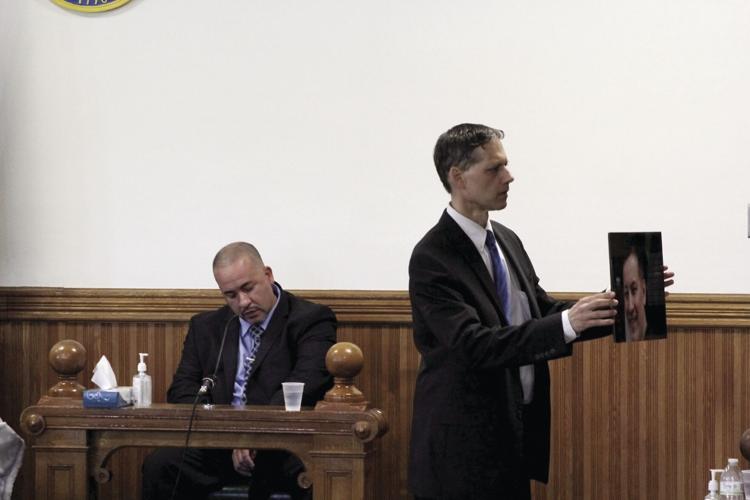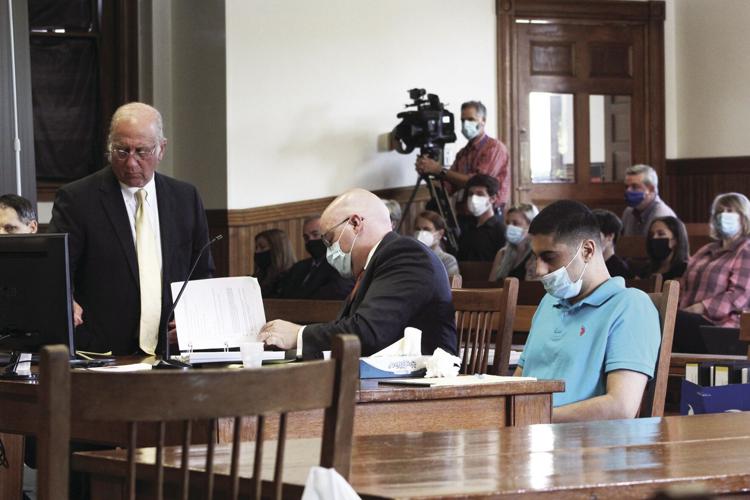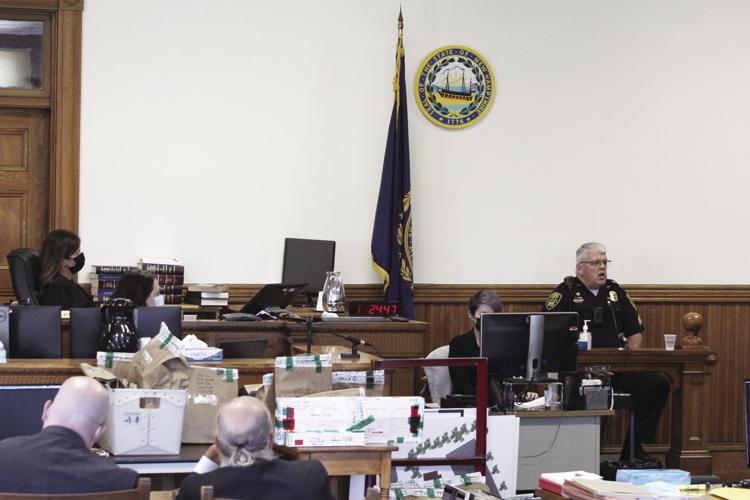LACONIA — Prosecutors argued that Hassan Sapry killed Wilfred Guzman Sr. in a fit of rage. But Sapry’s lawyer told jurors during opening arguments Monday that Guzman’s death was the consequence of a deranged mind.
For more than one hour the jury of nine men and seven women sat and listened as the prosecution and defense attorneys laid out conflicting explanations of why Guzman was murdered on April 18, 2019.
Senior Assistant Attorney General Danielle Sakowski said that for between 10 and 12 minutes Sapry “cut, stabbed, chopped, and stabbed” Guzman in the kitchen of his Blueberry Lane apartment. She told jurors Sapry, 24, inflicted more than 140 wounds on 57-year-old Guzman during the brutal attack.
“He acted with specific motive. He acted with premeditation,” Sakowski said.
But Sapry’s lead attorney, Mark Sisti, countered, “First-degree murder is not a rage crime. This is not a premeditated murder. It’s not even second-degree murder. This was madness.”
Sapry is charged with both first- and second-degree murder.
He is also charged with:
— Falsifying physical evidence for ditching Guzman’s cell phone on Gale Avenue.
— Theft of Guzman’s cell phone, wallet, and foreign currency.
— Four counts of attempted fraudulent use of a credit card for using two of Guzman’s credit cards in an attempt to buy $575 in video game merchandise.
— Criminal trespass for hiding out in an unoccupied house on Edgewater Avenue.
Sapry stood, along with Sisti and co-defense counsel Wade Harwood, as Belknap Superior Court Clerk Abigail Albee read the charges at the outset for the trial which is expected to last two weeks.
Sakowski charged that Sapry killed Guzman in an outburst of pent-up rage that had been building for months, fueled by insulting comments Guzman had made about Sapry’s Islamic faith and racial slurs.
“He admitted [to investigators] that he killed [Guzman] because of that anger,” Sakowski said, adding that Sapry said, when he was interviewed by investigators: “I was so angry that I could not let it go. It just built up.”
But Sisti said Sapry’s violent acts can only be understood as a break with reality — the result of years of mental illness and defect from which, the attorney argued, Sapry suffers.
The roots of his mental condition go back to Sapry's young childhood in Baghdad, Iraq. There, he said, he witnessed children in his school killed by suicide bombers, saw people in a car next to theirs in Baghdad traffic incinerated when another car was blown up by a roadside bomb, and suffered trauma when his father was taken captive by kidnappers who so beat and disfigured him that Sapry did not recognize his father when he was finally released.
“War is hell. Hell visited Baghdad, and hell visited a little boy. And,” Sisti continued, “hell plants seeds that don’t always grow into warm memories.”
As Sisti was sharing this with the jury, Sapry sat at the defense table and wiped his eyes with a tissue.
Sapry got to know Guzman through Guzman’s daughter, Natashia, who had been Sapry’s classmate since middle school. They spent time together and Sapry was a frequent visitor at Guzman’s apartment.
Sisti said that the extent of the brutality of the attack on Guzman, the randomness of the wounds to his body, and the weapons used are further proof that Sapry was not in his right mind when the homicide occurred.
“First-degree murders are not committed with forks and spoons. They are not committed with 140 wounds,” Sisti said. “This is the scene of craziness,” he said of the shambles in which police found Guzman’s body the following day. “This is an act of insanity. The result of the illness and defect is the death of his friend.”
The first witnesses to testify after opening arguments had concluded were Guzman’s son, an officer in the Laconia Police Department who discovered Guzman’s dead and mutilated body, and a State Police investigator.
Wilfred Guzman Jr. told the court he and his wife and their two children had traveled up from New York City on April 18 for a planned visit with Guzman Sr. They were unable to contact him during the trip, and when they arrived at Guzman Sr.’s apartment at about 12:30 a.m. on April 19, Guzman Jr. said he found the apartment dark and the door locked. They knocked at the door but there was no answer.
The family checked into a hotel. The next morning they tried calling Guzman Sr. once more, and again got no answer. Guzman Jr. then said he drove back to his father’s apartment at 57 Blueberry Lane and this time noticed what appeared to be blood stains on the back door. He then went to Laconia Police Headquarters. After police determined that Guzman Sr. was not a hospital patient they went to the apartment.
After someone on the maintenance staff of the Perley Pond Townhouses complex unlocked the apartment door officers went in while Guzman Jr. remained outside.
Guzman Jr., a New York City police officer, said when a female officer walked out of the apartment a few minutes later, “I could tell by the look on her face that it was not good.”
Laconia Police Sgt. Robert Cameron testified he was able to get into the apartment before the door was unlocked by crawling through an unlocked kitchen window. As soon as he got inside he saw Guzman Sr.’s body on the floor.
“I was certain that [Guzman Sr.] was not alive,” he said.
State Police Sgt. Christopher Martineau, an evidence technician, with the major crimes unit, testified about the signs of a violent struggle which he observed.
He said there were suspected blood stains throughout the apartment. In particular he said that the glass in the oven door was broken and blood stains were on the stove. There were blood-stained kitchen utensils, which prosecutors say, were used in killing Guzman Sr. There was a broken blade of an ornamental sword with blood stains, a smashed tube television set, and broken glass throughout the kitchen.
The weapons used to kill Guzman Sr. were shown to jurors, including a sword blade, forks, tongs, and a butter knife.
The jury was also shown photos of Guzman Sr.’s body lying on the kitchen floor.
When the pictures were shown on a monitor set up for spectators, a young woman seated in an area set aside for members of Guzman’s family began to cry and was comforted by another woman sitting next to her.
Under cross-examination, Martineau acknowledged that there were other far-more-lethal items handy in the apartment. Specifically there was a machete which was in the laundry room just off the kitchen, a long knife, and a set of cutlery in a butcher block knife holder which was on the kitchen counter. All of these items were apparently untouched and showed no signs of blood on them.
Drawing attention to the assortment of kitchen utensils used in the attack on Guzman Sr., Sisti asked Martineau, “Can you recall these used as a lethal weapon (in other homicides)?”
“I can’t think of any,” Martineau replied.




















(0) comments
Welcome to the discussion.
Log In
Keep it Clean. Please avoid obscene, vulgar, lewd, racist or sexually-oriented language.
PLEASE TURN OFF YOUR CAPS LOCK.
Don't Threaten. Threats of harming another person will not be tolerated.
Be Truthful. Don't knowingly lie about anyone or anything.
Be Nice. No racism, sexism or any sort of -ism that is degrading to another person.
Be Proactive. Use the 'Report' link on each comment to let us know of abusive posts.
Share with Us. We'd love to hear eyewitness accounts, the history behind an article.